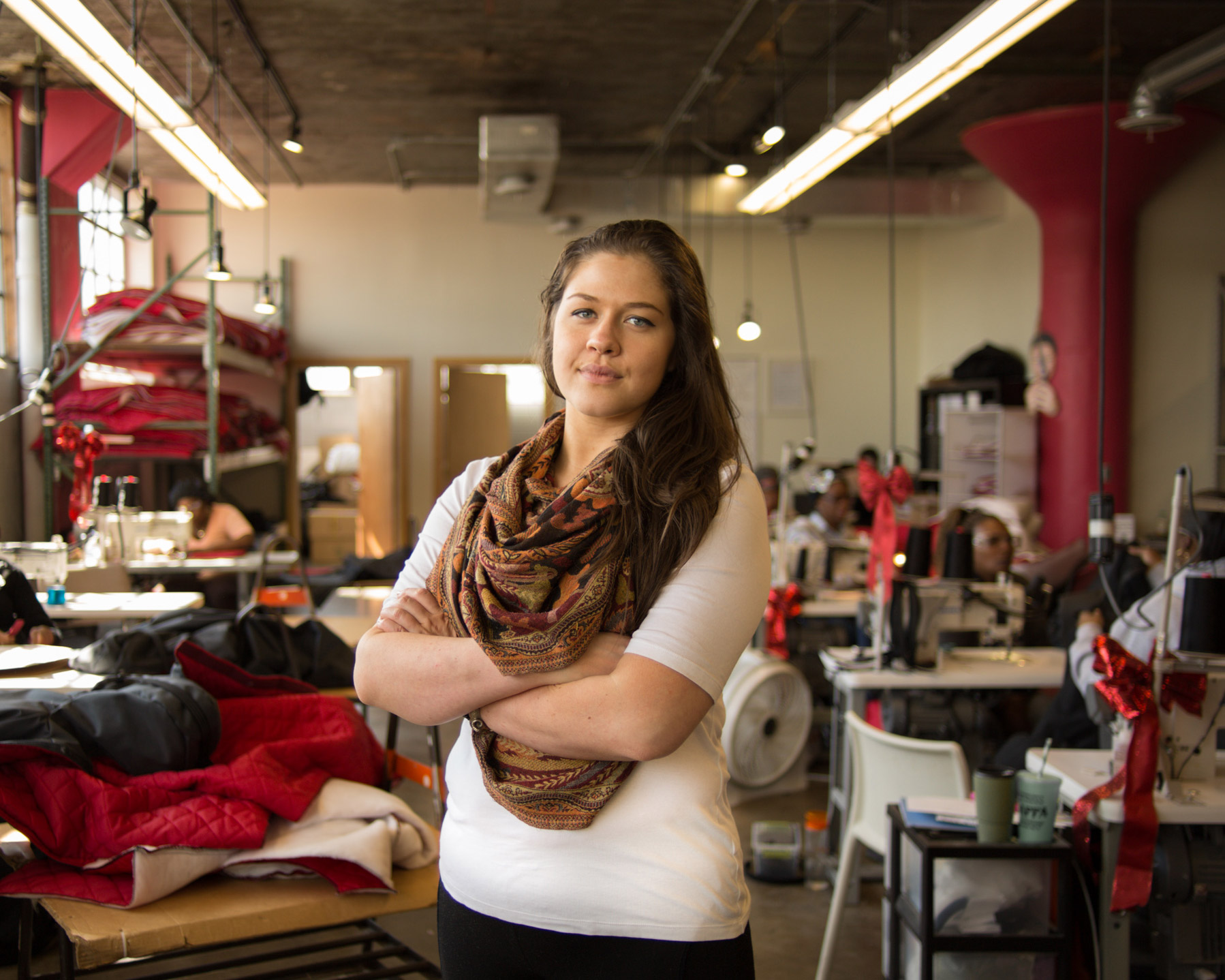
- Interview by Tina Essmaker March 25, 2014
- Photo by Jonathan Fambrough
Veronika Scott
- designer
- entrepreneur
- nonprofit
Veronika Scott is the 24-year-old CEO and founder of Detroit-based nonprofit, The Empowerment Plan, which employs and trains homeless women to become full-time seamstresses who make a coat that turns into a sleeping bag at night and a bag during the day. Funded by donations from foundations, companies, and individuals, The Empowerment Plan is headquartered at Ponyride and has been featured by the New York Times, NPR, The Discovery Channel, The Today Show, and more.
Interview
What was your path to starting The Empowerment Plan?
The Empowerment Plan began as a class project, but it was a long, organic path from there to making it a reality. I studied industrial design at College for Creative Studies in Detroit. While there, I took a product design class sponsored by a humanitarian group called Project H. All of the students had different internships within product design, but our main focus was on design and identity; we spent a lot of time working on the exteriors of products, but little time thinking about what happens once products get into people’s hands—for designers it’s all about making things look sexy and fast. (laughing)
When Project H came into our studio, they said, “You need to go out and talk to people; we want you to focus on the needs of the city.” After that, we talked to many different people who told us about problems that Detroit had—and still has—ranging from public education to transportation. Those resources are vital to a city’s well-being. However, we needed a problem that we could actually address, and something we heard over and over again from the people we talked to was that there were homeless people everywhere.
I started exploring various shelters to do research in, and I stumbled upon one called Neighborhood Service Organization (NSO). My grandfather and I went there one evening around 8pm to talk to people. I showed up with a bunch of ridiculous design tools like sticky notes, Sharpie markers, and questionnaires—I did not know what I was getting myself into. (laughing) We walked into a room where a group of homeless people were sitting and watching TV; they weren’t allowed to use the area for sleeping, and they were only allowed to be in there for eight hours at a time before the next group came in. The floor manager in charge turned off the television, pushed me out in front of the group, and said, “Good luck—you’re going to need it.” Everybody stood up and started swearing! They were pissed, and rightly so: I ruined their evening. So, there I stood, holding all of my ridiculous sticky notes and Sharpies up to my chest like they were going to protect me from bodily harm. (laughing) I told the group, “I’m broke, living with my grandparents, and I really need your help with my class project.” That was my first experience starting this.
My grandfather insisted that I go back to NSO at 8pm three times a week for five months, so I did. After talking to people, I found out that, on the streets, the nickname for NSO was “hell.” I had no idea it was such an intense place; it was rock-bottom for many people. It was a tough group.
There was a playground kitty-corner to the shelter. It was covered in clothes and tarps, and one of the play structures was used as a home for two people. I took a picture of it with my cell phone, and a week later it was completely torn apart and burned to the ground in a turf war. That was a pivotal point for me. I asked, “Why would you put yourself at such risk to create something being offered for free 20 feet away?” I started to understand that it wasn’t just about people trying to meet physical needs: there are a lot of places that provide the physical needs of shelter, food, and warmth, but they don’t meet the emotional needs of independence and self-reliance. People want to be able take care of themselves, and they’ll do whatever they can to do that. That is what first inspired the coat.
So, that’s when you decided that your product for the class would be a coat?
Yes, but I still had to recognize that designing my product wasn’t just about the physical side—I had to think about the rest of it, too. The first thing I designed wanted to be a coat, tent, and sleeping bag all in one, but it didn’t do any of those well. (laughing) I didn’t know how to sew, and my mother taught me as we sat upstairs in my grandparent’s house, using their home sewing machine. I seam-ripped five wool coats to make this Frankenstein-like monstrosity of a jacket, which took more than 80 hours to make. It turned out awful: it weighed 20 pounds, smelled funny, and was rough all-around, but I was proud of it. (laughing) When I brought it to the people at NSO, they took one look at it and said, “This is great, but it looks like a body bag.” I had used recycled trash bags, so when it laid out like a tent, the effect wasn’t so pleasing.
I decided to make another one because it was a class project and I wanted to get a good grade. Also, being in school allowed me the freedom to think, “This isn’t the end.” I made an ugly prototype, but there was a learning curve that allowed me to go back to the drawing board. It allowed me room to fail without really failing.
I did three different versions of the coat, and they were all horrible because I suck at sewing. (laughing) By the end of the project, I had gotten the street name of “The Coat Lady,” which was hysterical. One of the guys who lived at the shelter became a kind of spokesperson for my coats; his name was Pee-wee, and he had been on the streets for a total of 20 years, 15 of those being consecutive—that means he hadn’t had a single night off of the streets in 15 years. I recently found out that he passed away. He was a little guy, but he had the deepest, roughest, scariest voice around; everyone respected and feared him. Because of him, I got so many requests from strangers who came up to me on the street and asked if I was The Coat Lady; it was surreal. So many people asked for my jackets, but it seemed ridiculous to me: why on earth would they want something that was a school project? I thought: “I’m just a student. Nothing I come up with now is ever going to become a reality.” It was just for a grade.
Wow. You never planned for this to be anything other than a class project?
Never. For about two years, it was just a class project; I was cushioned and safe in my protective school bubble. It wasn’t until the day after I graduated from college that I considered officially launching a company. I had to make the tough decision to not apply for jobs elsewhere and actually try to do this. It was a tough choice, but once I made it, I never looked back.
“…there are a lot of places that provide the physical needs of shelter, food, and warmth, but they don’t meet the emotional needs of independence and self-reliance. People want to be able take care of themselves…That is what first inspired the coat.”
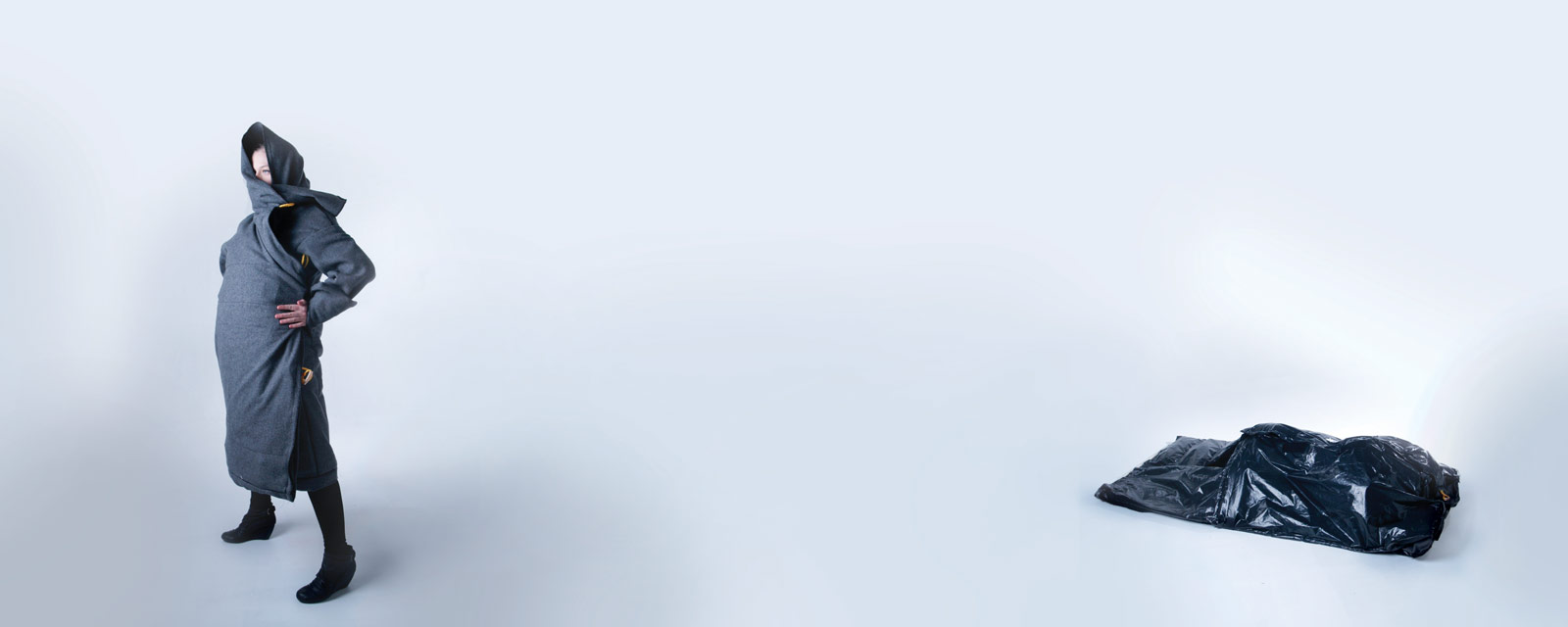
What was the transition like from graduating to actually creating this business?
It was a gradual transition that started with a meeting with Mark Valade, the CEO of Carhartt. I showed him my first, very well-designed business plan, which didn’t have much content to it, but it was very pretty. (laughing) He funded it and invested in the materials and machinery that I would need to get started.
Because of that, I had to do a lot of things quickly. Stage one was finding a place to put everything that Mark had just donated to me. What was interesting is that we found a space in the NSO shelter building: it was a closet that we painted green and put up a wall of cork in. It was so small that we couldn’t even build a full coat in it! It was a great start, though.
The next stage was realizing that I was never going to be a seamstress. It didn’t make sense for me to make one coat each week; it wasn’t a sustainable idea, and it sounded like torture. (laughing) I found a sewing teacher, but then had to find people for her to teach so we could start making coats. When we started looking for people to hire, the head of the NSO shelter said, “You know, we have hundreds of people who would come to volunteer with you if they just had the opportunity to do something every day.” I interviewed five people the first day, which was a surreal experience because I had never been on the other side of the interview table! A few people showed up; one woman came two hours early. I hired two people: Sig Sig and Elisha. They are both amazing individuals, and the work they did in the first six months pushed the company to become what it is now.
Aside from financial support from Carhartt, we had only been funded by a tiny PayPal donation button on the site—that helped pay for both of the ladies’ salaries for nine months. I never had to ask for money; people contributed, and it was amazing. I didn’t get paid, but those two ladies did, and I had enough gas money to get to the shelter.
It was astounding to see what Sig Sig and Elisha did with each of their salaries. They both worked the same hours and got paid the same, but Sig Sig didn’t have any children or family; Elisha did. Within three months, Elisha had moved out of the shelter permanently, found her own apartment, got it furnished, had her three kids enrolled in a charter school, and started her youngest on learning Japanese. During that same three-month period, Sig Sig was kicked out of the shelter, sleeping in her car, and had stopped showing up to work. I’m not saying anything bad about Sig Sig’s character; I had hired her right after she had gotten out of a decade in prison, and she was having a hard time adjusting.
That experience made me think about who I needed to hire. I had to hire somebody who was going to show up to work not just because they needed money, but because they needed to put food on the table for their kids; someone who needed to know where they were going to sleep that night so that they could take care of their family. People told me, “You’re never going to get a homeless person to show up to work,” but I did. I did it by hiring parents who wanted a better life for their kids and, at the end of the day, that was the motivator for them. We now employ 15 women who were all previously or are currently homeless.
That’s awesome. And now you have a space bigger than a closet?
Yeah. We had the closet for a good nine months to a year, but we outgrew it quickly. Now we’re in a building called Ponyride, which houses 14 other creative companies, like a dance studio, a metal shop, and a coffee house. It’s a very fun, creative space, and it offers us a lot of opportunities for collaboration. Moving into this building sent a message to everyone on the team who had stayed at the NSO shelter: you aren’t going to end up working in the same place that signified one of the roughest points of your life. Imagine sacrificing and pushing so hard to move out of a shelter and finally get stable footing only to come back and work at that same shelter every day. Moving on to a space outside of NSO meant that the women were no longer labeled as “those women who used to be homeless and lived here.” That doesn’t follow them.
“…I realized I was actually doing something personal…I grew up with parents who suffered from addiction and who were always struggling with money…Without the help of other family members, we would have been in the same exact position as many of the people I hire right now.”

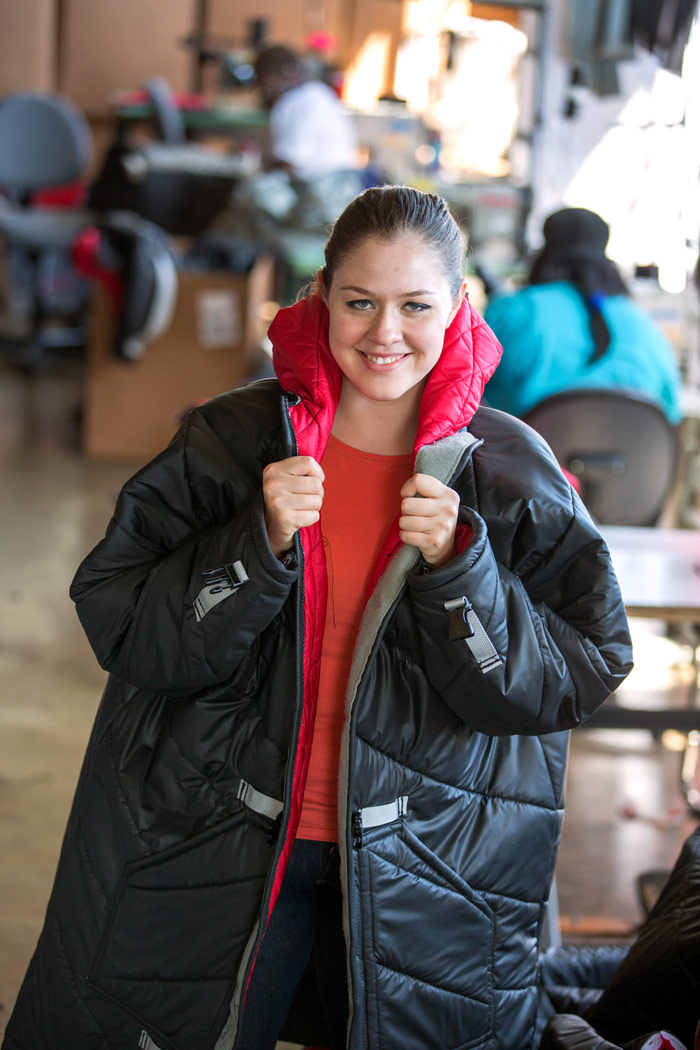
You give the coats away for free. Do you still receive funding from Carhartt or other organizations?
Yes, we still get a lot of support from Carhartt. In fact, the black outer shell and the bright red lining inside the jacket are donated materials from Carhartt. They have been like a parent figure for The Empowerment Plan because they do business in such a great way. Carhartt has been around for 110 years in Detroit, but they are a global brand. I’ve seen the plants where they make their products, and I’ve gotten to talk to people who literally retired at a sewing machine after working there for 40 years. Those people were able to retire with a high quality of life and pride in what they were doing. We have such a bad taste in our mouths about manufacturing because of sweatshops; it’s horrifying how badly people are treated in a lot of facilities, but that’s not the way it is with Carhartt. Another reason why I was lucky to have their support and guidance early on is because I knew nothing about garments or sewing. I thought there were two types of sewing machines in the world: the home kind and the industrial kind. (laughing) That was my entire experience with sewing and production.
Do you feel more confident in your abilities since starting the company?
Since working with Carhartt, I learned that I took the most difficult path by starting a manufacturing facility that is also a nonprofit. People tell me, “You went the hard way,” and I reply, “Well, I didn’t know that.” I just went the way that seemed to benefit my team the most, and I’m glad we did it this way.
We’ve been handing out coats for the past four years. In the first two years, we made just under 250 jackets. Again, that was when I still thought of it as just a class project and only had one other person working on it. It’s amazing now to see people wearing our coats out on the streets. We talk to them and hear feedback like, “This is way better than the white one you did three years ago,” or, “We love this, this, and this.” We want to know what they want out of the coats, and, in that sense, they have all been a part of the design process. They’ve taken ownership of it.
We try to keep most of them in Detroit, but we now get daily requests to distribute them across the US as well as globally. We’re lucky to have such a high demand for this product, and we’re growing to the point where we want to become sustainable. We’re possibly going to start doing a buy-one, give-one program that would allow people to buy one for themselves and provide one for someone on the streets. That’s our goal.
Would you describe the coat?
It’s actually very simple. There are three layers to it: a water-resistant outside shell; an insulation layer that is either Thinsulate or recycled car scrap from General Motors; and a quilted, water-resistant inside liner that prevents the insulation from rubbing off on the skin. We’ve done it in multitudes of different materials, and they all have different heat ratings. It’s a coat by day, which becomes a sleeping bag by night via a pocket that is velcroed up in the back. It can also be turned into an over-the-shoulder bag when it’s not being used or if you’re worried about theft on the streets.
How does it do in the weather?
In the past few weeks, Detroit has experienced temperatures of –40º and –20º, and our coats have been doing a great job—people have been excited to get them. There were a few days when you could start getting frostbite if you had any skin exposed for two minutes; in some shelters, we saw people whose hands were so swollen with frostbite that they couldn’t move, and some may lose their fingers because of it. The only people we saw who could stand to be outside were the people wearing our coats. Out on the streets, people wear layers of coats, some so old and shredded that they’re held together with bungee cords. It’s so hard to see, which is why it feels amazing to hand somebody a jacket when all they have on is a hoodie and pajama pants.
“Art school actually taught me a lot about business…Being forced to make things…and being asked to tell our stories over and over again set me up to be successful. It set me up to be able to tell a story without being afraid of criticism or having it destroy me.”
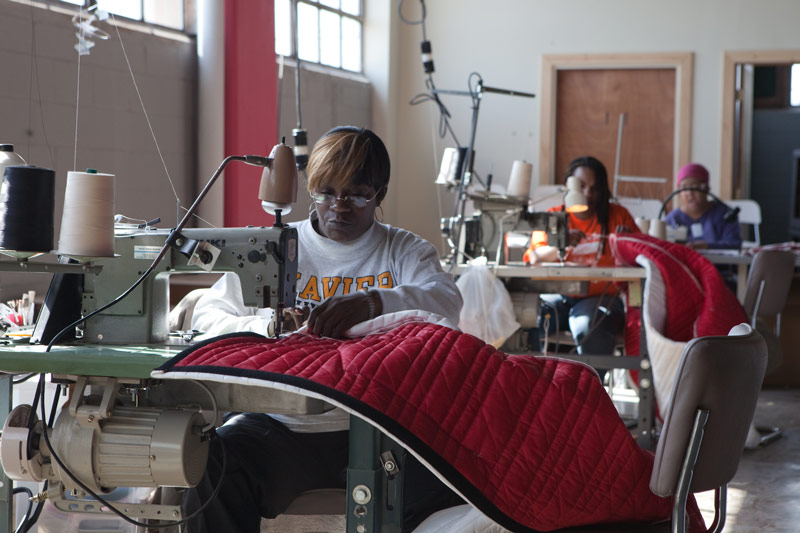
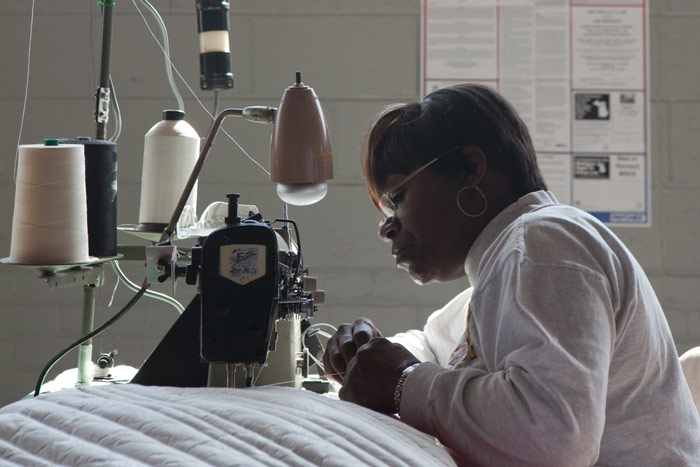
That’s incredible! Was creativity a part of your childhood?
After I graduated and began making this project into a business, I realized I was actually doing something personal—my life ties into this in a lot of ways that I didn’t recognize at first. I grew up with parents who suffered from addiction and who were always struggling with money. My two younger siblings and I experienced what happens when a family is constantly struggling, living below the poverty line, and doesn’t know if they can afford rent or food. Without the help of other family members, we would have been in the same exact position as many of the people I hire right now. People and families can be destroyed in situations like that; it’s terrifying, and it leaves a lot of anger, resentment, and frustration behind.
To answer your question, I was always creative growing up. I enjoyed painting and drawing very much and they came easily to me. I could escape into art, and that was how I dealt with a lot of stress. Throughout high school, I was lucky enough to be exposed to people like my grandparents. They had worked hard and it paid off; they were happy and had a comfortable lifestyle. On the other hand, I was also exposed to my parents, and I knew what it was like to be raised in someone else’s rock-bottom life. It would have been easier to fall into my parents’ pathway of becoming addicted and giving up on school, but I’m so grateful I had exposure to something different. It was a light at the end of the tunnel.
Near the end of high school, I applied to art colleges and was accepted into quite a few good ones, like Rhode Island School of Design. In the end, I went to the College for Creative Studies (CCS) in Detroit, which was not my first choice. I hate to say that, because it sounds like I’m throwing them under the bus, but it was just so physically close to where I grew up! Like any college student, I wanted to move as far away from home as possible. However, my grandparents insisted that it was probably the cheapest option for me. My grandfather told me, “You are not getting into debt. There is no such thing as ‘good debt,’ and I refuse to let you graduate college with hundreds of thousands of dollars to pay off for the rest of your life.” That was in 2007, right before the economic crash. The College for Creative Studies offered me half of my tuition in scholarships and the other half in financial aid, which meant I would basically be going to school for free. So, I went! (laughing)
Art school actually taught me a lot about business. The school had world-renown designers who came into our classes with red Sharpies and said, “All of your ideas suck.” (laughing) Being forced to make things over and over again and being asked to tell our stories over and over again set me up to be successful. It set me up to be able to tell a story without being afraid of criticism or having it destroy me. The best thing that art school taught me was that criticism does not mean that you are going to fail.
That’s important, because when you get out into the real world, it’s not just about theories. It’s not as idealistic as when you’re in school, and people will criticize you, but if you believe in what you’re doing, you just keep working at it.
People criticize you because they expect you to do better—they don’t just criticize you so that you’ll stop. That’s the whole point of criticism. You’re going to have bosses who tell you, “This sucks,” but they don’t want to you to say, “I give up!” They want you to go back and make it better.
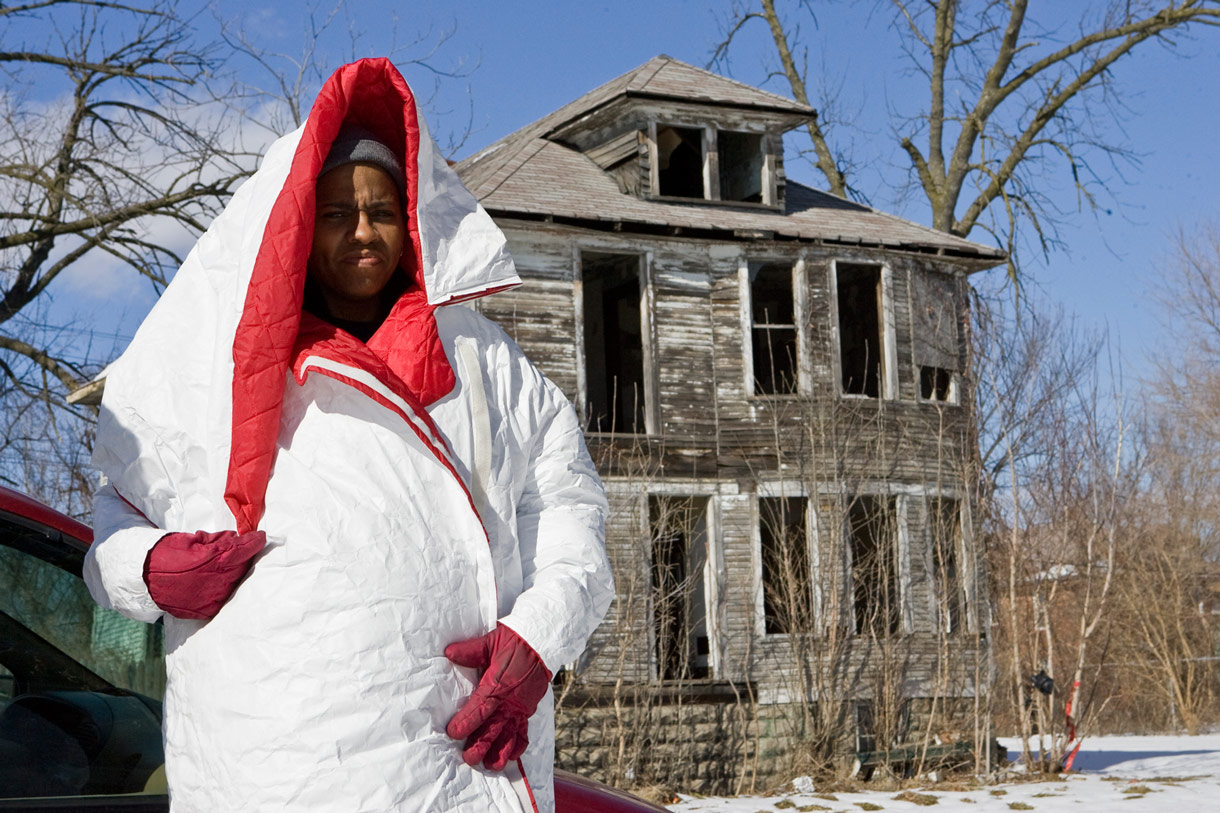
“…unbiased, innocent, excited, blind ambition is amazing when you want to start something. Had I known everything I would have to go through when I started this company…I probably wouldn’t have done it.”
Did you have an “aha” moment when you realized that you wanted to focus on product design?
I don’t think I ever had an “aha” moment with product design—it was tough. It was like trying to get a badge of honor for having made it through because half the class dropped out in the first year. For some reason, I never thought about quitting. I cannot tell you how many sleepless nights I worked back-to-back; you just never stop. (laughing) It was also hard because I was only 1 of about 7 women out of 150 people in the program. At the same time, it was rigorous and felt like the right amount of intense college courses plus art.
With The Empowerment Plan, there were so many different “aha” moments. I had a moment when I realized that I needed to create jobs rather than just a product. At the end of the day, the reason people got excited and stayed excited was the employment piece. People are excited because of the women and how amazing and powerful they are.
In order to make The Empowerment Program work as a company, I had to actually go for it and not work anywhere else—no one else was going to do this. That was a big, big choice for me to make because people are programmed by college, and by so many other outside forces, to believe that we need to have outside work experience before going out on our own. To decide that I was going to start this right out of school, instead of believing that I could go back to it in five years, was a very tough decision for me to make.
The funniest “aha” came six months after I made that decision. I had a space and an intern, and we were going to try! (laughing) On the day before my 23rd birthday, I got a call from the editor-in-chief of Forbes Magazine, and he said, “You’re being vetted against 5,000 other interesting NGOs.” I said, “Wow, cool! Why?” And he replied, “I can’t tell you anything yet, but send us a video and we’ll see if you get in.” I sent him a video, waited, and heard back that he would see me in New York—in a week. I asked what I would be doing, and he explained that I was attending the annual summit that Forbes hosts, and that this year’s theme was philanthropy. I was going to this event to present alongside two other NGOs from other countries, and the rest of the people in the room were going to be from the Forbes list of the 100 wealthiest people in the world!
Oh my gosh!
It was hosted at the New York Public Library, of all the awesome places. Unfortunately, I had to drive to this amazing event from Michigan with a friend because I was not one of the Forbes 100. (laughing) When we arrived, they told us that Oprah was going to open the event; after that, Diane von Fürstenberg, the head of the Acumen fund, one of the founders of USA Today, and Melinda Gates were all going to sit on a panel, and that’s when I was to go on. Afterward, Warren Buffet spoke and then Bill Gates did a thing during dinner, and I just thought, “What am I doing here?!”
I would have been so nervous!
I was so nervous! And I only had 5 to 10 minutes on stage, so I just word-vomited everything out as fast as possible. A couple people connected with it, which was amazing. That’s how I actually ended up meeting Dan Gilbert, who is a fellow Detroiter. He asked, “How come I’ve never heard of you?” It was a surreal moment and at the same time felt like a huge message in neon lights telling me that I was on the right track and that I should keep this up. I had received blatant, straightforward signs in the form of people on the streets asking me for jackets and in the women we hired who were doing so well. This was the first time that I had gotten intense validation outside of the small community I was a part of. That confirmed that it wasn’t just a good or cute idea; it was a bigger-picture idea. That moment felt like a dream, and it was the first time I thought of any of this as being bigger than me.
“It’s important to be able to have the fortitude to look at criticism as constructive, rather than something to make you quit. It’s great fuel, and it becomes sort of like a to-do list.”
Have you had any mentors along the way, personally or professionally?
Personally, my grandfather is a big mentor. He really shaped who I became and was always pushing me. It was easy to fall behind in school or think about giving up, but he forced me to do it. It wasn’t fun at the time, but he made sure that I knew that it was my one way out of that life. He helped me know that I wasn’t doing it alone.
One of my biggest professional mentors has been Mark Valade and the Carhartt family. Back when The Empowerment Plan was a class project, before anyone else said, “I like your idea,” he supported me. Why would the CEO of a multimillion-dollar, international company sit down with a college art student who was carrying around a trash bag? (laughing) I had a completely under-developed business plan, but Carhartt saw something and pushed for it to work. That was a huge boost of confidence and, again, it let me know I wasn’t doing this alone.
Another mentor of mine was Imre Molnar, the dean of CCS. He actually passed away about a year ago. When people at CCS heard about my project, most said, “Oh, this is cute and everything, all this charity stuff you’re doing, but you need to get back into consumer goods.” Imre was one of the few people who said, “No: this can be real.” He had 20 years of experience as the design director for Patagonia and moved to Detroit to be the dean of CCS without having taught there. He told me, “You know what? If these people won’t teach you, then I will!” So he put himself on as faculty for a couple semesters just to sit down and teach me. He guided me along my path and it gave me confidence.
Another mentor when I first started the project was Steve Shock, a teacher who I had at CCS. Now, there are a lot of new mentors coming in to help us, like Phillip Wm. Fisher of the Max M. and Marjorie Fisher Foundation. I don’t have nonprofit experience, and he has been helping me figure it out from day one. Honestly, The Empowerment Plan wouldn’t exist without all the people around it. People say to me, “It’s so amazing what you’re doing,” but it’s not just me—do you know how many people have helped me get to this point? I’m here because of all the people who have valued me.
What has been the biggest risk you’ve taken to move forward?
There are so many different, very large risks that I and others have taken for this project. For me, making the decision to not go work somewhere else was a big risk. It doesn’t seem like that big of a risk now, but some of my family said, “You know that you could get money somewhere if you applied for some jobs, right?” I didn’t recognize how important that was at the time because I felt like, worst-case scenario, I’d be okay.
The Empowerment Plan is growing and changing, and there’s a big risk on the horizon: moving to a buy-one, get-one model. This is the way that we can become sustainable, and it is risky, but it will create more jobs that are even bigger than the ones we have created so far.
Are your family and friends supportive of what you do?
Yes! Many of my friends helped when I was first starting. One friend, who was an advertising student while I was studying product design, helped me write the catchiest and punchiest words to say on stage when I had to give my first speech. The first hundred photos were done by friends who were photography majors. Some of my friends acted as construction workers when we moved into our new space. We had to restore the building after it was partially abandoned, and they had to do some pretty gross stuff. (laughing) My friends are very supportive.
I also have a supportive family. My siblings, who are 10 and 14, like to come in to work with me when they’re on break from school. I’m trying to do for them what my grandparents did for me: I want to show them that there is a light at the end of the tunnel, and that there is a different path they can go down.
Do you feel a responsibility to contribute to something bigger than yourself?
Yes, and I think that’s where most of my stress comes from nowadays. I have a team now and I am helping them pay their bills; I’m partially responsible for their well-being and livelihood. I also have a responsibility in how I represent them when I go out and tell this story. It definitely weighs on me, but in a great way: it reminds me why I’m doing this and that there’s a bigger picture. It keeps me from doing typical 24-year-old activities, but I also get a lot of enjoyment out of it. People say, “You must never go out and have fun or socialize,” but I get to do amazing things and meet people from all around the world. I have fun, just in a different way than most 24 year olds.
“…The Empowerment Plan wouldn’t exist without all the people around it. People say to me, ‘It’s so amazing what you’re doing,’ but it’s not just me—do you know how many people have helped me get to this point?”
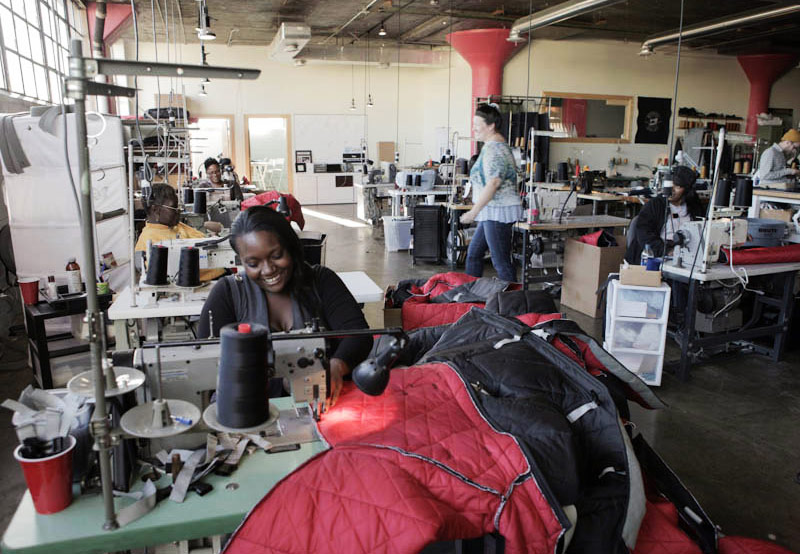
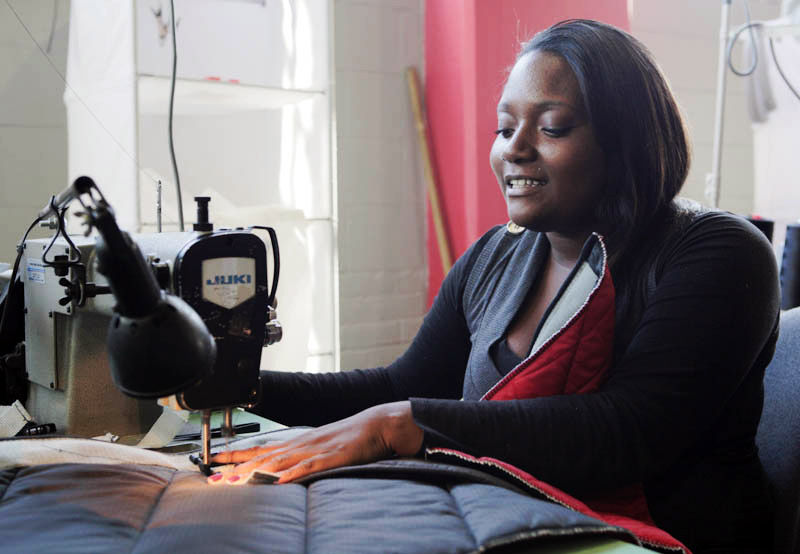
Are you creatively satisfied?
I am creatively satisfied. I don’t think I was ever going to be satisfied with a job drawing every day. I think the reason I’m so satisfied at The Empowerment Plan is because my mind is constantly engaged. When you’re sketching, it’s easy to zone out and think you’re being creative, even though sometimes you’re just putting shapes on paper. With The Empowerment Plan, it’s always something new, every day.
Is there anything you’re interested in doing or exploring in the next 5 to 10 years?
I am constantly changing and adapting with The Empowerment Plan, and I want to continue to be open to that change and growth, not knowing exactly where I’ll be, what I’ll be like, or what I’ll have. Although, it doesn’t matter what I have: I love my tiny apartment in Detroit and my used car (laughing)—I don’t care about all the rest of it. Of course, I have big dreams for what The Empowerment Plan will be: people in the community learning from women in shelters; teaching parents how to code and use CAD or 3D printers to start their own companies; starting a clinic, and a daycare center, and all of these things. It’s going to be awesome!
I have an idea for where I want to go, but I’m keeping it loose because I know it’ll change. The Empowerment Plan will always hire the same people, and it will always have to be good for the team, but outside of that, we can adapt.
What advice would you give to a young person just starting out?
I’m still relatively young and bright-eyed; I’m still jaded about some things and not others; I’m still open to the possibilities of things working out when they don’t seem like they will. It is great to be bright-eyed and bushy-tailed when you’re starting something, and that’s the attitude I had when I started The Empowerment Project. People said, “This is going to fail in so many ways,” so I asked, “How many ways?” And I wrote them down. People said, “You’re never going to get any money without a business plan!” So, I thought, “Oh, I didn’t know about business plans. I guess I should make one of those.” Being naive and innocent actually helped me, and companies like Google and Pixar exemplify that attitude, so don’t let people beat that out of you.
People can be pessimistic, of course, but think about all the companies that are now huge—companies that were started when someone was in college or younger—that are doing great things. All it took was someone saying, “People say that this isn’t going to work, but I think it will.” That unbiased, innocent, excited, blind ambition is amazing when you want to start something. Had I known everything I would have to go through when I started this company—the rough points or even the simple things with finances and taxes—I probably wouldn’t have done it.
You also have to have the strength to deal with criticism. It’s important to be able to have the fortitude to look at criticism as constructive, rather than something to make you quit. It’s great fuel, and it becomes sort of like a to-do list. You shouldn’t write criticism off like people don’t know what they’re talking about, but at the same time, you will get hit in the face with somebody who thinks that what you’re doing is crap. You have to be willing to go through that if you want to start something.
How does living in Detroit impact the work that you do?
I wouldn’t have been able to start The Empowerment Plan anywhere else. Detroit is such a unique mixture of issues and problems, but at the same time, there is a community here that is unlike any other. If you have lived here for the last 5 or 10 years, you can see that there has been a lot of positive change.
In Detroit, there is a sense that if you want something bad enough, you can make it happen. There are few cities like that now. People describe a place like New York City as the land of opportunity, but it isn’t: you’re not going to have the same opportunities that you would if you moved to Detroit and said, “I want my business here,” or “I want to start something here.” In Detroit, even the biggest entities, from Quicken all the way to General Motors and Ford, are excited about supporting tiny entities like me. It’s about competition, but not about beating everybody else out. Right now, we realize that all the ships need to rise with the tide; everybody needs to come up in order for the whole city to be successful. It’s not about a successful few who stomp everybody else out.
Is it important to be part of a creative community? What is it like in Detroit?
The creative community here is, again, unlike any other. It’s tough, intense, and proud—as it should be. Being a part of a creative community means that your ideas can become better by being around others who think differently and are willing to work with you. It’s important for me, because I don’t think I’d be as successful if I wasn’t part of a group that is always trying to do something new, exciting, and unexpected. That’s what Detroit is: a lot of things are unexpected. On top of that, there’s so much great music, food, and art.
“In Detroit, there is a sense that if you want something bad enough, you can make it happen…It’s about competition, but not about beating everybody else out. Right now, we realize that all the ships need to rise with the tide; everybody needs to come up in order for the whole city to be successful.”
What does a typical day look like for you?
There is no such thing as a typical day for me, period. It changes all the time. I’m at Ponyride about 80% of the time, and I might have a lot of meetings depending on the week. Sometimes I travel, but that’s usually only three months out of the year. It’s difficult to describe my job: I do whatever needs to get done, and that means a lot of different stuff.
What music are you listening to right now?
I’m listening to music from two of my friends, actually. One of them is named DJ Shiftee, who I met at a conference in Montana. The other one is a guy named GRiZ, a Detroit-based artist who embodies the spirit of Detroit techno with funk music. A couple friends and I were reminiscing about the crazy days of Detroit, including the music, and a lot of it was funk. There used to be a thing called Funk Night that took place every month in an abandoned building that was turned into a giant party with old-school funk bands. I’m not just about indie music, though: I like a couple Katy Perry songs. (laughing)
Any favorite movies or TV shows?
I don’t have a TV, but I do have a laptop, which is basically the same thing. (laughing) I have a balance of favorites. When it comes to TV, I am, of course, a fan of True Detective and Girls—pretty much anything on HBO. Then there is reality TV and shows like Top Chef, which I love to watch; I am down with any cooking show. (laughing) It has nothing to do with work, and it has nothing to do with the tough experiences of the ladies I work with—somebody is just making a cake, and I’m going to watch that for the next two hours. It’s quite meditative.
Do you have a favorite book?
That’s a hard one, because I have about seven. Right now I’m reading a book called The Tao of Physics. I like A Brief History of Time by Stephen Hawking, but one of my favorite books of all time is Good Omens by Terry Pratchett and Neil Gaiman. I could probably benefit from reading some business how-to books, or Blink by Malcolm Gladwell, but I still can’t get into it. It’s sci-fi, crazy fantasy, and intense literature only for me, thank you.
Do you have a favorite food or a favorite spot to eat in Detroit?
My favorite food is Thai, and Detroit has some of the best pad thai with all these crazy local restaurants that have been around forever. I like Supino’s pizza, but I live right next to Motor City Brewing Works, which also has amazing pizza, and it’s hard not to go there to eat every day of my life. (laughing)
Are you downtown?
I’m in Midtown next to a lot of iconic restaurants and the new Shinola store. It’s cool. Ponyride is in Corktown, and it was actually started by the guy who opened Slows Bar BQ—that is the ultimate in guilty pleasure food. I would love to eat a pound and a half of that macaroni and cheese covered in pulled pork, but I’m trying to eat healthier meals, like Detroit Zen Center kale salads.
What kind of legacy do you hope to leave?
That’s a tough one, because I’m not yet at the age when you start to think about leaving a legacy. At the same time, being responsible for a company makes me want to have people continue to work and embody what I am trying to create. It’s important to think about that as we grow.
I hope I can continue the idea of giving people a chance rather than just saying it. People in prison say that if they do their time, they’ll be able to start their lives over when they get out, and it’s not true. We are very quick to judge and push people away. I want to give people a chance without judging them by what they’ve been through or what they were raised in. People should be given opportunities rather than being expected to hide from who they are. I hope that the idea of being able to benefit from a blank slate and being able to accomplish so much with so little continues beyond me.
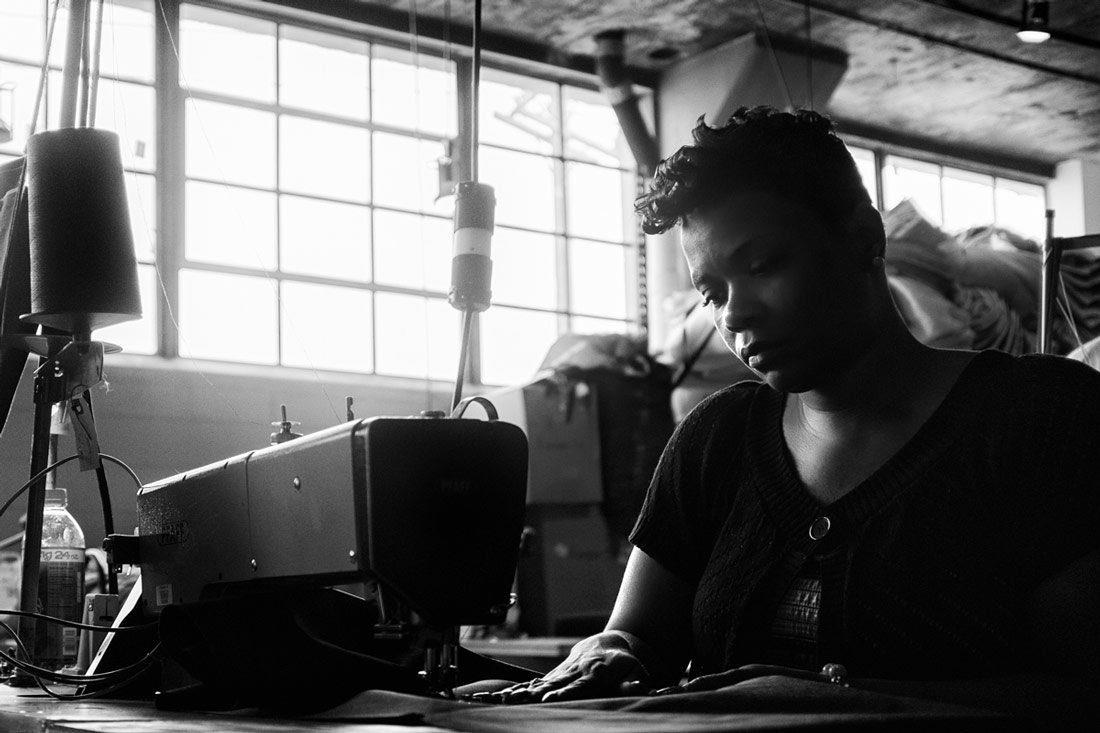
“I want to give people a chance without judging them…People should be given opportunities rather than being expected to hide from who they are. I hope that the idea of being able to benefit from a blank slate and being able to accomplish so much with so little continues beyond me.”